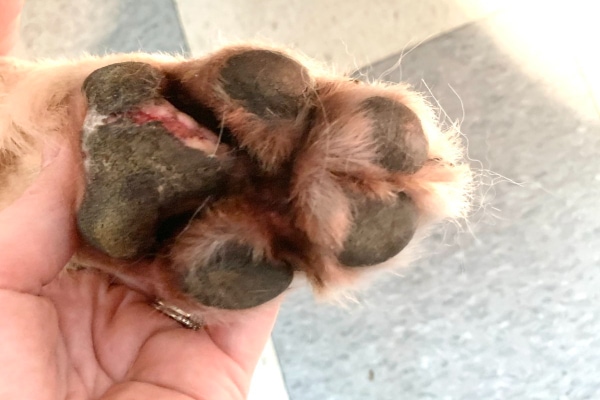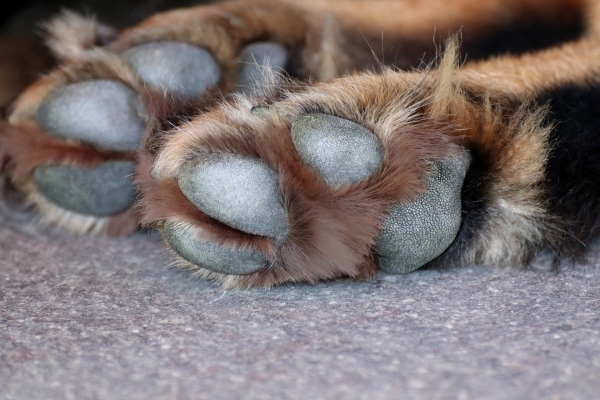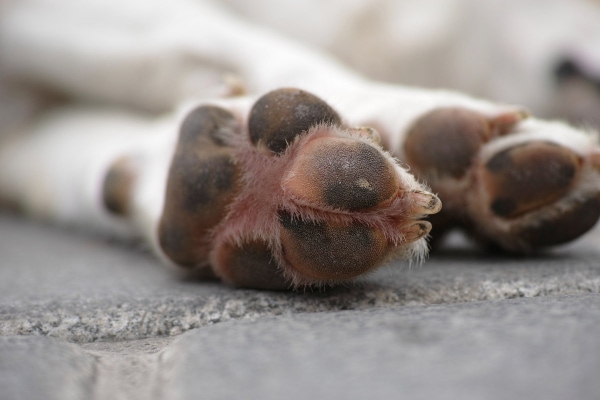If the words “red” and “itchy” describe your dog’s paws, a yeast infection could be the culprit. Integrative veterinarian Dr. Julie Buzby gives you the scoop on dog paw yeast infections, including the causes, predisposing factors, symptoms, treatment options, and prevention strategies. Plus, you’ll find dog paw yeast infection pictures throughout the article.

Especially in the warmer months of the year, but to some extent all year round, dogs with itchy, red, irritated feet come walking through my clinic doors. Some of them even plop down in the waiting room or exam room and start licking and chewing at their paws almost instantly.
These poor dogs are distressed because their feet are so itchy. And their poor parents are upset because they hate seeing their beloved pups so uncomfortable.
While there are a variety of reasons a dog may have itchy red paws, a paw yeast infection definitely ranks high on that list. Thankfully, with the proper treatment and a good prevention plan, I can usually offer these dogs (and their parents) some much-needed relief.
What is a dog paw yeast infection?
As weird as it might sound, yeast and bacteria are a normal part of your skin and your dog’s skin. However, sometimes the number of yeast (or bacteria) gets too high. Or an abnormal type of yeast begins to grow on the skin.
When there is yeast overgrowth, this is called a yeast infection (or a fungal infection). A dog yeast infection can happen on any part of the skin. But it is most likely to occur in areas with lots of skin folds and trapped moisture. This makes a dog’s paw the perfect environment for yeast to start multiplying out of control and causing problems.
Why do yeast infections tend to occur?
As you just learned, some amount of yeast is normal on a dog’s skin. So this means that if your dog has a yeast infection, it is probably secondary to some other issue. Conditions that can set the stage for a yeast infection include:
- Food or environmental allergies, which cause itchy skin
- Bacterial infections of the skin (i.e. pyoderma in dogs)
- Presence of a wound (such as a cut or puncture hole from a grass awn or foxtail)
- Hypothyroidism in dogs
- Auto-immune diseases
- Skin cancer
These diseases can weaken the skin barrier. Plus, the body’s immune system and the dog’s skin are already busy working hard to deal with those conditions. This makes it easier for yeast to escape the body’s defenses and rapidly multiply. The resulting yeast overgrowth and skin inflammation are also known as yeast dermatitis.

How do dogs get yeast infections on their paws?
A dog’s paws are one of the most common places for this to occur. Because the paws are contacting the ground, they are exposed to more “damaging” elements. All the grass, dirt, weeds, and water that touch your dog’s paws can cause your dog’s allergies to flare up. Or they can cause cuts, irritation, or trapped moisture. If this happens, your dog’s skin barrier can weaken, allowing yeast to grow out of control.
Additionally, these elements can cause dogs to lick their paws more frequently. The saliva adds moisture and the repetitive licking of the paws breaks down the skin barrier. Plus, airflow to the spaces between the toes is pretty limited. These factors set up the perfect environment for a yeast infection.
What are the predisposing factors for a dog paw yeast infection?
As you are probably noticing, there are three things that yeast love:
- Warm, moist skin
- Small spaces or skin folds without good airflow
- Skin with a weakened defense
If any of these are present on your dog, he or she might be predisposed to developing a yeast infection. Let’s take a closer look at these factors.
Warm, moist skin
Have you ever bought a brand-new loaf of your favorite bread to take camping with you? Maybe you threw it into the cooler to protect it on the drive out. When you got to your destination, you pulled it out and set it in your warm car to be used later.
However, you didn’t notice that some of the ice had melted in the cooler. When the time came to make the perfect sandwich, you were met with a wave of disappointment. Your bread was moldy!
What does moldy bread have to do with dog yeast infections? Let me explain!
Mold is a fungus, and so is yeast. Just like mold rapidly grew on your warm and moist bread, yeast does the same thing on your dog’s warm and moist skin. This means that if you have a dog whose feet are frequently damp, he or she could be at risk of developing a yeast infection. Some of the risk factors for moist paws include:
- Swimming or walking in water
- Being recently bathed
- Frequently licking the paws
If your dog falls into any of these categories, it is important to check the paws regularly. If you notice your dog’s paws are wet, you should dry them to help prevent yeast infections. The dog paw yeast infection picture below shows what yeasty paws look like…

Skin folds and tight spaces
Skin with lots of skin folds or small spaces (like in between the toes) are the perfect places for yeast to develop. The skin folds prevent good airflow. As a result, these areas are more likely to trap and retain moisture.
This means that certain dog breeds (such as those who are known for having extra skin) are also predisposed to developing yeast infections. Some of these breeds include Shar-Peis, English Bulldogs, and French Bulldogs. Additionally, excessive hair can also trap moisture in a dog’s paw. Thus, dogs with hairy feet can be at increased risk of developing a yeast infection.
Skin with a weakened barrier
As I mentioned previously, yeast infections usually occur secondary to another problem. Therefore, dogs who suffer from diseases that compromise the skin barrier (such as the ones we talked about earlier) are at increased risk of developing yeast infections in their paws.
Dog breeds who are predisposed to other skin problems like allergies are more likely than other dogs to have pododermatitis (i.e. inflammation of the skin on the paw) which can lead to yeast infections. Some of these breeds include Golden Retrievers, Boxers, Labrador Retrievers, Dalmatians, Shih Tzus, and Staffordshire Terriers (Pitbulls).
Additionally, senior dogs are at an increased risk of developing yeast infections on their paws. This is partly due to the fact that their immune system is not as good as it once was. If the immune system is weak, your senior dog will have a difficult time fighting off opportunistic yeast infections.
Senior dogs can also have a more difficult time grooming themselves properly. If they are suffering from osteoarthritis in dogs, they may not be able to clean their paws as well. This means there may be more bacteria and debris trapped between the toes, which weakens the skin barrier.
Genetic predisposition
There are some dogs that are thought specifically to be genetically predisposed to yeast infections. These include:
- West Highland Terriers
- Cocker Spaniels
- Lhasa Apsos
- Dachshunds
- Basset Hounds
- Shetland Sheepdogs
- Malteses
- Poodles
- Chihuahuas

What are the symptoms of a dog paw yeast infection?
If you know your dog is at risk of developing a yeast infection, there are some common symptoms you can watch for at home. These include:
- Red paws
- Hair loss
- Itchy paws
Yeast infections can cause red dog paws in two ways. First, the skin of the paw might be red and irritated. Secondly, the hair might also have red or pink salivary staining from excessive licking and chewing of the paw. Sometimes there can be brown discharge around the base of your dog’s nails too.
Yeast infections can also cause hair loss on the paw or other parts of the body. They can be painful and irritating to your dog too. If this happens, your dog’s paw might be sensitive to touch, and you might be wondering, “Why is my dog limping?”
Additionally, yeast infections can give your dog itchy paws. You may notice that your dog is excessively licking or chewing his or her feet due to the irritation and itchiness.
If your dog is showing these signs and you suspect he or she might have a paw yeast infection, please consult your veterinarian for diagnosis and treatment.
How will my vet diagnose a dog paw yeast infection?
In order to diagnose a yeast infection, your veterinarian will start by performing a physical exam on your dog. Part of that includes carefully examining your dog’s paws for redness, irritation, or other signs of a yeast infection.
If your veterinarian suspects a fungal infection, he or she will likely recommend a skin swab, skin scrape, and/or tape impression of the affected area. These are all methods to collect cells and organisms from the skin. The veterinarian will apply the collected material to a microscope slide and then examine it for bacteria, footprint-shaped yeast, parasites, or abnormal cells. Alternatively, the vet may decide to submit the samples to a veterinary diagnostic lab.
Depending on your dog’s specific case, the veterinarian might recommend additional testing. This could include performing allergy testing, taking a skin biopsy, or running some blood work such as chemistry, complete blood count (CBC), and thyroid levels (T4). The vet may use these different tests to determine the cause of your dog’s skin irritation and help manage any underlying diseases.
What are the treatment options for a dog paw yeast infection?
Once your vet has diagnosed your dog with a yeast infection, he or she will come up with a treatment plan that is specific to your dog’s situation. It may sound simplistic, but the key to treating yeast infections (or most other medical problems) is to closely follow your veterinarian’s instructions. Doing this will help prevent the infection from persisting or getting worse.
There are a few treatments that your vet might suggest. One option is to use an antifungal medication, which may be a pill that you give your dog by mouth. This can sometimes be challenging if your dog won’t take pills well. Alternatively, your vet might recommend an antifungal cream, wipe, or ointment that you can apply directly to your dog’s feet.

The vet might also send your dog home with a medicated shampoo. When using these antifungal shampoos, the directions might tell you to leave the shampoo on your dog for a specific number of minutes before rinsing. Most shampoos state that this should be about five minutes. But it is best to follow your veterinarian’s instructions and/or read the label when bathing your dog to ensure you use the product correctly.
(To learn more about properly using shampoos and other topical treatments, check out this Veterinary Partner article on topical therapy for skin conditions.)
Finally, the vet will discuss ways to address the underlying cause of the yeast infection. We will talk about that more in the prevention section since while it is an integral part of resolving yeast infections, it is arguably more important for preventing them.
Be patient and keep the follow-up appointments
It is important to note that treating yeast infections can take a long time in some cases. If your dog has a complicated yeast infection, he or she may need several rounds of treatment. During this time, your veterinarian might want to see your dog for some follow-up appointments. These visits allow your vet to monitor the effectiveness of the treatment and watch for any potential side effects of the medications.
Are there any home remedies for a dog paw yeast infection?
As we just finished discussing, the best thing you can do is to take your dog to the vet for potential yeast infections or other skin problems. However, there are a few home remedies you can try that might help your dog.
The first thing I recommend is taking your dog’s diet into consideration. If your dog is suffering from food allergies, change his or her diet to something less triggering. For many dogs, this means finding a “sensitive skin diet” or a diet with a different protein (such as buffalo or elk). While these sorts of diets are available over the counter, you may end up needing a prescription veterinary diet. If you need help, talk to your veterinarian about what diet is best for your dog.

The next option is to try treating your dog’s yeast infection with a paw soak. For example, using a gentle, odor-free soap can help break up debris and remove extra bacteria on your dog’s foot. Or Epsom salts can help remove grass awns from your dog’s paws. They also can be soothing for your dog’s skin. You need to be careful that your dog doesn’t drink the soak water though.
I have also had clients ask me about treating the yeast infection on their dog’s paws with apple cider vinegar. However, apple cider vinegar can be very harsh on your dog’s skin. If your dog has a cut, wound, or sensitive skin, it could burn and hurt your dog when applied.
Also, apple cider vinegar can dry out your dog’s skin, which may or may not be a good thing. Some dryness might be helpful since yeast like moist areas. However, it is problematic if the skin becomes too dry. For this reason, I recommend speaking with your veterinarian about your dog’s specific scenario before using apple cider vinegar.
Home remedy reminders
I have two parting words of advice about at-home treatment for yeast infections:
- Before trying a home remedy, discuss it with your veterinarian. While home remedies can be helpful, using the wrong ones can make a paw yeast infection worse.
- Sometimes the best treatment plan is to rely on the medications your vet provides and then focus the at-home part of the plan on preventing future yeast infections. After all, the best and safest home remedy is prevention.
How do you prevent paw yeast infections?
There are several great ways to reduce the chances your dog will continue to get yeast infections. After all, as the saying goes, “Prevention is the best medicine.”
1. Keep the paws clean and dry
Remember that fungus likes warm and moist environments. So it is important to prevent these types of environments on your dog by keeping your dog’s paws clean and dry. You might want to consider trying these at-home strategies:
- Shave/clip extra hair on your dog’s feet (especially between the toes), If you need help, be sure to ask your groomer or a veterinarian.
- Rinse then dry your dog’s feet after he or she has been outside, especially if he or she walked in dirt or weeds. This will help clean the paw and remove any allergens or irritants.
- Dry your dog’s paws if they are wet from swimming, being out in the rain, etc.
- Check your dog for grass awns such as foxtails.
- Ask your vet if you should use antifungal wipes on your dog’s feet on a regular basis. These wipes can be a great way to remove debris and control the yeast population on the feet. Ensure you wipe between the toes on both surfaces of the paw and around the nail beds for maximal efficacy.
2. Manage the underlying cause

Another important part of prevention is managing any underlying diseases that might be making your dog more prone to yeast infections. For example, if your dog has allergies, it is important to keep his or her allergies in check. Your veterinarian can suggest some allergy medications for dogs or other helpful remedies. This will promote good skin health and avoid an opportunity for fungal counts to increase.
You can also talk to your vet about ways to help improve your dog’s skin barrier health. This may involve omega-3 fatty acids for dogs, which have great skin and coat benefits as well as anti-inflammatory properties.
3. Monitor your dog carefully
Finally, check your dog’s paws regularly. If you know your dog is prone to skin problems or yeast infections, it is important to monitor him or her closely. Catching yeast infections early will make them much easier to treat. It also will prevent your dog from becoming as painful or uncomfortable.
Help your dog get a handle on paw yeast infections
Dog paw yeast infections can certainly make your dog’s feet itchy and uncomfortable. Sometimes it may feel like your dog will never get the relief that he or she (and you) so desperately wants. But the good news is that with the help of your veterinarian, appropriate treatment, and the use of these preventive strategies, your dog can often become significantly more comfortable.
So if your dog is licking and chewing at his or her feet and you notice that the skin and/or hair in those areas is becoming red, please do your dog a favor. Schedule an appointment with your vet. That way he or she can figure out if it is a paw yeast infection—or something else—that is causing your dog so much distress. That way your dog’s paws can start feeling better soon and you can focus on more exciting things like your next adventure together.
Has your dog ever had a paw yeast infection?
Please comment below.


My boy Luka (Collie/Mutt 8 yrs) has had a hard time with a diagnosed yeast infection on his paws and has been taking Ketoconazole 200mg daily for nearly 3 months. Vet won’t test for dust mite sensitivity because “testing doesn’t work.” But the carpet is gone now and although the pills have helped, Luka still licks front left paw and rear right paw. Luka has been on a unique protein diet. When I again questioned the Vet about a test for dust mites, he said that by now the yeast are dead and the primary allergen (dust mite poop) is now causing the problem with his paws. Does my story resonate with any of you guys? What about those home testing kits? Thanks in advance for any and all feedback. Sandra
Hi Sandra,
I understand your concern for Luka with these ongoing allergy issues he is facing. It is true that blood tests and in home testing kits for allergies really are not reliable. The gold standard is intradermal skin testing (just like with people). If you truly want to get a diagnosis, this would be the best way. You can ask for a referral to a veterinary dermatologist and they would be able to do the testing and guide you through the treatment process. Also, if you have not done a true diet trial that could be helpful as well. A novel protein dog food doesn’t necessarily equal a hypoallergenic diet. Hoping you can find the answers you need to restore Luka’s health and well-being. Wishing you the best of luck and keep up the good work!
Get a second vet opinion.
I found this article while looking for something that kills yeast but doesn’t sting, so I appreciate the advice on apple cider vinegar, I suspected it was hurting them.
Unfortunately, I must respectfully disagree with your advice to ask our vet first. Maybe you could add a step to find a vet that you truly trust.
We’ve been going to the same guy for over 10 years. He was fine for vaccines, but a growing problem started about 7 years ago. First he said yeast, then allergies, would only treat one of the 2, and the problem slowly grew. I wish I could post pictures. I cry every time I clean them I feel so horrible for giving this guy the benefit of the doubt. If it gets bad, it will cover your pet’s entire body. They have yeast oozing out of every orifice. I use baking soda water or miconazole, but hours later, more has oozed out to cover them. They’re suffering.
We’ll have to travel an hour for another vet, but it’s worth it. I’ll never go back.
Meanwhile, I really need more info, but all the articles on the web only mention minor paw yeast. If your dog has no allergies or other health problems they’re probably just itchy. My 2 girls have allergies and they’re both red and bleeding in and around every fold.
Hi Heather,
I am sorry your girl is having these severe skin issues and I understand why you are concerned. The reason we recommend you ask your vet first, is there is an assumption that you do have a good working partnership with your vet and there is mutual trust in the relationship. It can be tricky to make a definitive diagnosis with skin allergies and infections without extensive testing or even referral to a dermatologist. It is hard for me to make specific conclusions about the care you have received without being personally involved and knowing all the details. If you are unhappy with the service you have received, it is ok to seek a second opinion and have your pets established as patients elsewhere. Not every vet clinic is the perfect fit for every client. If your dogs have yeast oozing all over their bodies, then it is time to get a referral to a specialist. Praying for answers and a clear path forward. Best of luck to you and yours!
My dog got a yeast infection from wearing boots during ice/snow and then we left them on when it helped him with traction on the hardwood floors. Sadly, he is a tripawd currently undergoing chemotherapy so I am not wanting to mess with his gut flora by using antibiotics. So, I am using Farm Dog Harmony Topical Yeast product containing: Almond, English walnut, Tamanu, and Black Cumin Seed oil. Dried Calendula, Echinacea, Mullen Leaf, and Pau De Arco Bark. Essential oils of Frankincense, Roman Chamomile, German Chamomile, Geranium, and Petitgrain. Organic Vitamin E..
He has an appt in a few days to have blood drawn checking numbers from cancer and going to ask for a topical. I am here looking at the toe grips as his confidence with traction on the hardwood floors was noticeable.
Hi Erin,
I think ToeGrips could be a big help to your boy. Just know that since he is only using three legs, he may need to have the ToeGrips applied with a bit of glue to help keep them on. Also, if he is still very active there is a higher risk the ToeGrips may not last as long as hoped. They were designed for senior dogs that have decreased mobility and are less active. If you decide to give ToeGrips a try and run into any issues, don’t hesitate to reach out to our customer care team at: [email protected] They can help troubleshoot and also send you the video that explains how to apply ToeGrips with glue if needed. Hoping the natural product will help to resolve the yeast infection and praying the recheck will offer some good news. Wishing you and your sweet boy all the best. Take care!
I have a dog with feet problems (right front and left rear, I hope “just” a fungal infection). She licks at it profusely to the point her toes are raw and “meaty looking”. Anyway, she had a terrible time on my wood floors because she was only bearing most of her weight on the other two feet. I put down rugs on any bare floors and it has helped her a lot..
Hi Cheryl,
I am sorry your pup is having these severe issues with her feet. I am glad the rugs seem to help with the discomfort and reluctance to walk inside. If you have not had your vet evaluate this foot problem, I highly recommend you schedule an appointment for an exam. Hoping you can get some answers and find the best treatment to offer your girl relief. Praying for healing and wishing you all the best.
Just bought an antiseptic tea tree foot wash for my dog. Used it the last few days and it has soothed her paws. It is from boots
Hi Zanne,
I am glad you have found a great solution for your dog’s irritated paws. I tried to look up this specific product and could not find it. Please just be cautious with tea tree products for dogs. While they can offer great benefits, they can also be toxic if the concentration of the tea tree oil is too high. Most studies I read said that dog products should contain 1% or less of tea tree oil to be safe. Thank you for sharing your experience with us! Best wishes!
JANUARY 14TH 2024 HI MY BOY BLUE I NOTICED HE HAS BEEN LICKING AN BITING HIS PAWS A LOT AN HE IS LOOSING HIS HAIR AROUND HIS PAWS TOO ,I SEEN ANOTHER DOG THAT HAD THAT SAME PROBLEM IN THE MOTEL I WORK AT YOU DONT THINK HE MIGHT HAVE GOTTEN IT IF I HAD BROUGHT IT TO MY ROOM FROM PETTING THE OTHER DOG WITH HIS SKIN LIKE THAT .PLEASE FEEL FREE TO LET ME KNOW I DONT KNOW WHAT I CAN USE FOR HIM BUT GIVE HIM OATMEAL BATHS AN THATS NOT REALLY WORKING EITHER .HELP MY BIY BLUE PLEASE THANK YOU ROBERTA MURPHY
Hi Roberta,
I am sorry Blue is having this issue with his feet. Without examining him myself, I can’t say for sure if this is a contagious disease or make specific conclusions. I think it would be best to contact your vet and allow them to do an exam. They can help get a diagnosis and guide you toward the best treatment. Wishing you and Blue many happy days ahead and praying for a quick resolution.
My dog has the weirdest thing happening to her paws. They have a weird thing growing out of two of her paws. They look like worms, or something like underwater in the ocean, like the live coral . I have never seen anything like this, I know I need to get her to the vet, but I wanted to see if anyone has seen this kind of thing on their pup? I have soap my vet gave me for my other dog for his paws when he had yeast, but nothing like this came out of his paws. Please advise if anything like this has a name, and if so what are home remedies if any until i can get her to the vet? If i could upload a pic, I would, craziest thing ever.
Hi Carla,
What you are describing sounds a bit like a keratin horn/cutaneous horn (which also goes by other names), but without seeing your dog I can’t say for sure if that is the case. Hopefully you were able to get some answers at your vet visit so that you have a better idea of what you are dealing with.
Feel free to give us an update on what it ended up being.
my dog had the same thing…eventually they broke off…but now that same paw has a yeast infection….
Very informative article! Just realized last night that my beagle has yeast infection in between her toes. I have veterinary prescribed topical foam and shampoo on hand. We’ve been treating one paw with the foam for an inflamed hotspot, but I didn’t realize the extent of the infection until I decided to shave out her paw pads. Thankfully I already have the supplies on hand needed for treatment from a previous vet visit, but diligence is key. Missing a few days of treatment will allow for a flare-up.
Hi Jengaraine,
Thank you for the kind words about the article. I am sorry your Beagle is dealing with these skin issues, but it seems like you have everything well under control. Thank you for sharing your experience with us. Good luck and keep up the good work!
Hi Dr Buzby
My staffy x huntaway dog Marley is 3 years old. He has had his paws flare up in the last 6 months. He gets very itchy over his belly, legs and paws and chews his paw pads off. So he has been living in an E collar for months. Its been super frustrating and upsetting to see him react to something. Yet he’s still a happy boy.
His ears get very smelly like yeast, with dark brown wax. When they get cleaned with a light dilution of apple cider vinegar OR sensitive ear cleaner, after 2 days the ear is smelly and full of wax again. He enjoys the ear getting cleaned when I’m rubbing the ear, but becomes very irritated after – running around the room, increased saliva, rubbing his ears over everything, huffing and puffing.
He also has dark spots on his inner thighs and armpits. He itches these areas alot after walking outside. We live rurally and are in contact with lots of grass and plants.
We have been consulting with our vet and have been directed the following over the last 6 months:
– bath in water after each walk on grass
– occasionally anti-bac bath
– dry paws and between toes well
– skin support prescription diet
– antibiotics (Noroclav) for 2 weeks
The round of antibiotics seemed to clear up his glue like paws and wounds, and looked great. After one night, back to chewing his feet again and is hopping around.
My vet has swabbed and investigated his cells and it came back inflammed with bacterial cells.
We have also been given a steroid tablet which is great short term, but not a long term solution with high side effects.
Other treatments I have added to Marley’s care are:
– omega 3 oils
– probiotic powder (olives kitchen)
– apoqueil
– booties while walking when his paws have been chewed off
I’m very disheartened with what to do, it seems I’ve tried a lot of different things and my vet or myself don’t know what it could be. Is there something you can advise.
Thank you, Rebecca
Hi Rebecca,
Goodness all this just sounds very frustrating, and I am so sorry Marley is suffering with these severe symptoms. Allergies can be difficult to treat especially when you don’t know what is causing the underlying problem. You are doing everything I would normally recommend during an active flare up. The best advice I have is to think about a consultation with a veterinary dermatologist. They can do skin testing if needed to narrow down the culprit so treatment can be focused on the worst triggers. I know seeing a specialist is a financial investment, but it would end up saving you money in the long run if you didn’t have to keep buying medications and treatments that only act as a band aid instead of treating the underlying problem. Once you have your boy’s condition stabilized, you can monitor for signs of a flare up and act to prevent the worse inflammation before it gets out of control. Here is a link to another article with more information: Allergy Medicine for Dogs: 9 Solutions to Calm Your Dog’s Itch
I hope you can partner together with your vet to find the best way to restore Marley’s quality of life. Wishing you both the best of luck and praying for relief for your pup.
my dog is suffering from paw infection since 3 years when he was 1 year old and now he is 3 . Even after treatment by vet all injections antibiotics and anti allergic medicines provided to him . That white discharge and yeast paw gets cured for few day but later on it again repeats we are giving him full diet of grains like rice and wheat(roti) I’m fed up with this problem what should I do now
Hi Gauri,
I understand why you are frustrated with this ongoing paw issue. These infections can be extremely difficult to control. In some cases where allergies are the underlying problem, the goal is to keep symptoms minimized and treat flareups when they occur. Without examining your dog, myself, it is hard to make specific recommendations. Is there an option to schedule a consultation with a specialist/veterinary dermatologist? I wish I had some great insight to offer but unfortunately there are just too many unknowns. Hoping you can find the answers you need to help your sweet boy live his best life. Wishing you both the best.
Hi my lab has chipped and torn off part of her paw. I went to the vet and gave me spray chlorhexidine spray to help her. I believe it started from yeast as everytime I take her into fields her paws turn red. Now part of her paw cushion is torned off. the vet told me it will come back but I am not seeing success in the treatment. I tried some tea tree oil the redness left but her paw cushion is still chipped off and she s licking it bringing back the infection. I tried covering it but situation went worst with humid weather. please help me I feel so sorry for her I m doing my utmost to help her regain her energy and happiness. she s in pain. thanks
Hi Marica,
I understand your concern for your Lab and this paw injury. Unfortunately, without examining your dog myself, I can’t tell the severity of the situation and don’t know what is best to recommend. Please make sure your vet is aware of this ongoing issue. They need to know the pad is not healing or regrowing. You may have to use a cone/E collar to keep your pup from licking the affected area and causing a bigger problem. I hope you can find the answers you need to allow your sweet girl to make a full recovery. Wishing you both the best of luck.
My cockapoo suffers with yeast infections and has done since being a puppy. He is now 7. Are there any probiotics your could recommend or suggest I could look in trying or certain foods to cut from his diet.
Thank you.
Hi Zoe,
I am sorry your dog struggles with yeast infections on his paws. I am not sure I would recommend removing foods from his diet but that would be a great question for a veterinary nutritionist. Your vet should be able to contact a specialist in your local area and schedule a consult if needed. My favorite probiotic is FortiFlora made by Purina, but there are many other options out there that are also good choices. Your vet probably has one they like and recommend. I suspect they have one in the clinic with which they have seen good results.
What do I do when sprays, shampoo, apoquel or cytopoint does not help. My dog will not let me touch his feet. He will bite me if I try.
Hi Pat,
I am sorry your dog is one of the many that suffer from allergies and side effects from them. If all of the usual treatments are not helping, it may be time to see a specialist. Make sure your vet is aware of these concerns and you can discuss a possible referral.
My dog suffers with paw chewing too. I am now thinking he has a yeast infection, as he is prone to that and gluten intolerant. Grain free diet. But lately he has been eating non grain free treats more than usual at the local pub. I checked his ears last night and they also looked like they were a bit yeasty in their. I used organic cider vinegar to clean them including water too and I just dowse a cotton wool ball and clean them. He likes it. I also had to get a cone to stop him chewing and I am now washing his food in a weak solution of cider vinegar and cooled bo boiled water . So everything is being washed carefully with that, ears and paws. I’ll let you know. He is a huge dog and he seems ok with the vinegar, in fact he likes it and licks the cotton wool balls.
Hi Vanessa,
If you are suspicious your pup has a paw yeast infection, I highly recommend you have him examined by your vet. I would be cautious with the vinegar and water as too much moisture can actually make a yeast infection worse. Also, has your dog been diagnosed with a grain allergy? The only reason I ask is most people assume grain to be the culprit of most food allergies for dogs. But it is much more common for dogs to be sensitive to the protein in their food. Since grain free foods have become more popular, we are seeing a dramatic increase in cases of heart disease in breeds that are not typically prone to this issue. The heart disease has been linked to a grain free diet. My main point is I know you are trying hard to handle this issue at home and it sounds like you would do just about anything for your pup, but make sure you are partnering with your vet to maintain your sweet boy’s health and wellbeing. Wishing you all the best.
What if you cant afford a vet visit?
Dear Lost in America,
I understand that sometimes due to circumstances out of our control we may end up in a situation where a vet visit is not an option due to financial limitations. While it is always best to try and get a diagnosis before starting a treatment regimen, there are some home remedies you can try for this specific problem. I encourage you to read the section of the article titled “Are there any home remedies for a dog paw yeast infection?”. Best wishes and good luck!